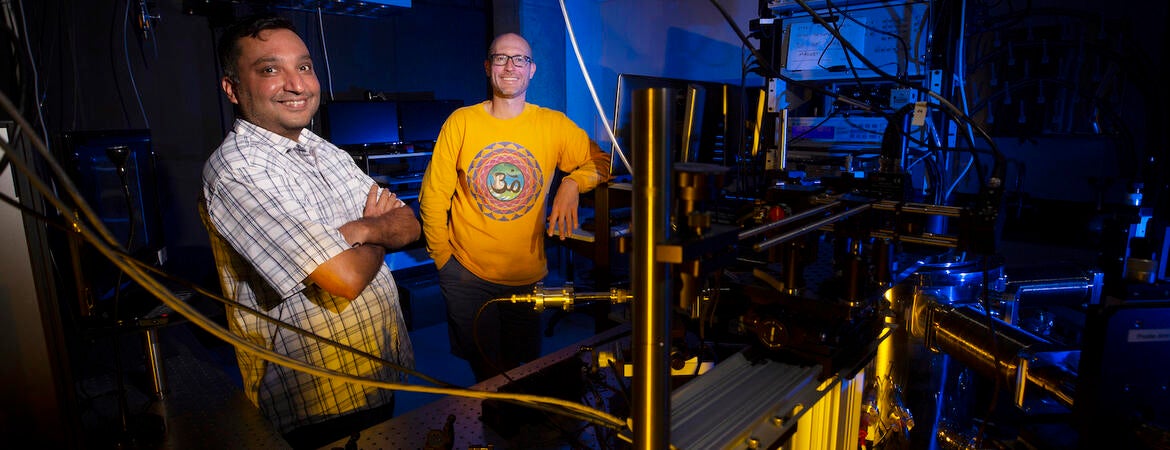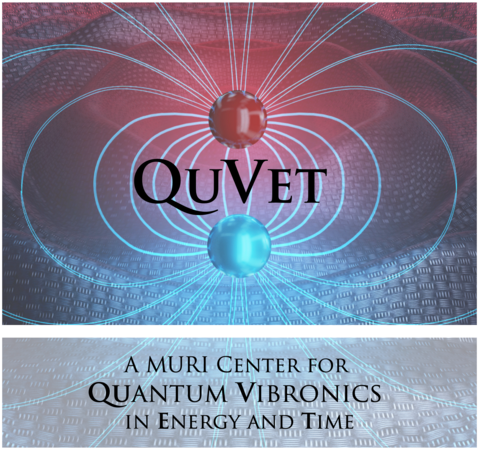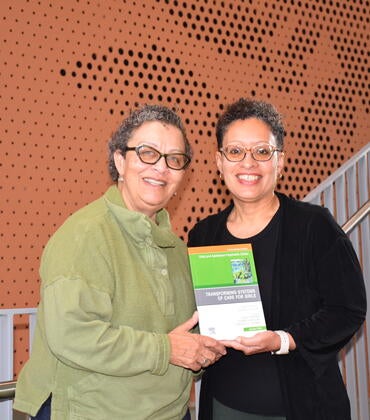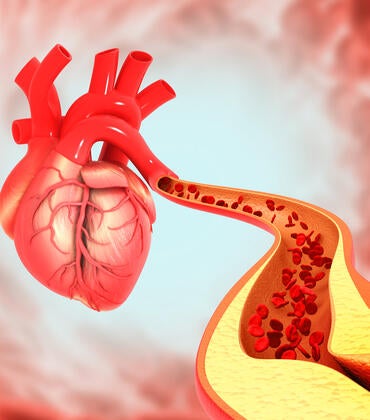
Physicist Nathaniel Gabor at the University of California, Riverside, has been awarded a $7.5M grant from the Department of Defense, or DoD, to develop a Multidisciplinary University Research Initiatives, or MURI, center on campus. Called QuVET for the Center for Quantum Vibronics in Energy and Time, the center’s co-principal investigators are leading scientists at UCR, Caltech, MIT, and Columbia University.
“Vibronic,” a portmanteau of vibrational and electronic, refers to transitions between molecular energy states. Vibronic behavior is central to both biological and material systems and could impact future technology’s energy harvesting efficiency. Vibronic effects — vibrational transitions that accompany electronic transitions — occur in systems ranging from photosynthetic light-harvesting antennae to molecular gases and solid-state materials.
Gabor, a professor of physics and astronomy and the five-year grant’s principal investigator, believes the strong partnership with DoD laboratories and industry will position QuVET to be a scientific and technological epicenter for quantum vibronics. He said the visionary science QuVet represents could place UCR at the head of a new era of science, where biology, physics, and chemistry are explored through the lens of quantum mechanics.
“This is science at its best, bringing a lot of positive attention to UCR,” said Shan-Wen Tsai, chair of the Department of Physics and Astronomy. “QuVet will open up many good research opportunities for our undergraduate and graduate students.”
In the following Q&A, Gabor, a leader in the fields of quantum materials and photosynthetic light harvesting research, discusses his vision for the new center he will direct. Vivek Aji, a professor of physics and astronomy at UCR and the grant’s co-principal investigator, also shares his thoughts.
Q: Specifically, what research will QuVet focus on?
Gabor: At the length scales of atoms and molecules, atomic vibrations can strongly affect the wave-like behavior (quantum nature) of electrons. When vibrations and electrons interact, the resulting behavior can only be described as vibronic. We have assembled a team of physicists, chemists, biochemists, and biologists to overcome three critical challenges in achieving new technologies that harness quantum mechanics:
(1) In many molecular and material systems, vibrations act to remove energy from electrons, decreasing the overall efficiency of energy transport. However, photosynthetic organisms have adapted to instead harness vibrations to enhance the efficient movement of energy. In new molecular and material systems, can we achieve the same outcome of photosynthesis in order to enhance transport towards ultimate efficiencies?
(2) Tuning the interaction between atomic motion and electronic states via experimental control remains impossible, prevented by scientists’ inability to engineer materials at the atomic scale. Can emerging biochemical strategies and novel materials enable direct control over the wave-like behavior of electronic and vibrational excitations?
(3) Design principles do not exist for next-generation quantum systems, which implement strong vibrational effects. How can we take inspiration from biology to develop new technologies based on exotic states in which vibrations directly affect electronic behavior?
Q: What will the collaboration with Caltech, MIT, and Columbia University scientists involve?
Aji: The QuVET team brings together leading researchers in disciplines ranging from quantum physics (UCR and Columbia) and quantum chemistry (Caltech and Columbia) to biophysics, biochemistry (MIT and UCR) and quantum materials (Columbia and UCR). Each member of the team brings unique expertise that strategically covers a broad scientific base. Since the center goals are ambitious and attempt to solve a major trans-disciplinary problem, it is important that each of the team members is a creative thinker and cross-disciplinary scientist.
Q: Why is now a good time for a center like this?
Gabor: The theoretical understanding and experimental control of vibronic behavior is complicated by the wide range of physical processes that also occur in complex systems, such as the molecular light harvesting antennae of photosynthesis, where vibronic effects play the most important roles. Indeed, a complete quantum treatment of vibronic effects does not exist.
Biology, physics, and chemistry converge at the atomic and molecular scale, where quantum mechanics becomes vastly more important than at large scales. As our research technologies have advanced — and we collectively study molecules and materials at smaller and smaller length scales — more and more studies point to quantum mechanics as a means to understand emerging behaviors. Recently, it was discovered that the vibrational motion of atoms plays a critical role not only in the remarkably high efficiency of photosynthetic organisms, but also the efficiency of energy transfer in electronic materials. Our projects are among the first to explore the ability to engineer the interaction between vibrational motion and electronic states, heralding a new era of quantum science.
We believe quantum vibronics will have a major impact on fundamental science and technology involving both the biology/biochemistry of quantum processes in light-sensing and the understanding of novel optoelectronic properties in quantum materials — two fields at the forefront of basic research within the DoD.
Q: What sets this center apart from other centers like it elsewhere?
Aji: Currently, no other center focuses strongly on vibronic effects and the possible future technologies that would result from a deep understanding of quantum vibronic phenomena.
QuVET takes such a strong multidisciplinary approach to the challenges we have described here. Vibronic effects occur in many places in nature and understanding them fully requires a very special combination of people and expertise.
Q: What do you hope this center will achieve?
Gabor: I hope this center marks a pivot towards trans-disciplinary science at UCR. With resources that are committed wisely, UCR could be the leader in emerging topics where quantum mechanics describes the interface between physics, chemistry, biology, and engineering.
Further, QuVET provides both undergraduate and graduate students with a unique opportunity to enter a fast-growing field — bio-inspired quantum vibronics — at its very outset and to steer its growth. The tightly integrated nature of the tasks will facilitate sharing of knowledge and resources between groups. Together with the strong collaborative ties between UCR, Caltech, Columbia, and MIT, this will create a multidisciplinary learning environment for students, fostering the development of young scientists with a unique blend of theoretical, materials and advanced spectroscopy expertise.
Header image shows Vivek Aji (left) and Nathaniel Gabor. (UCR/Stan Lim)




